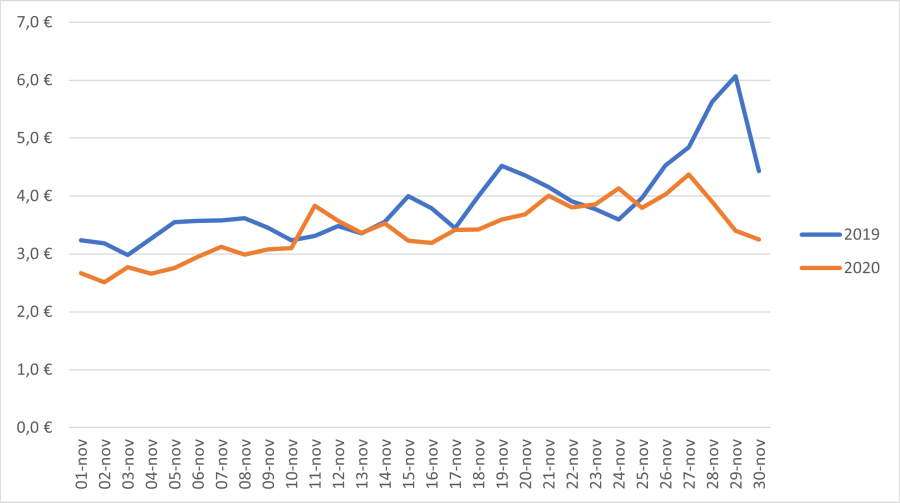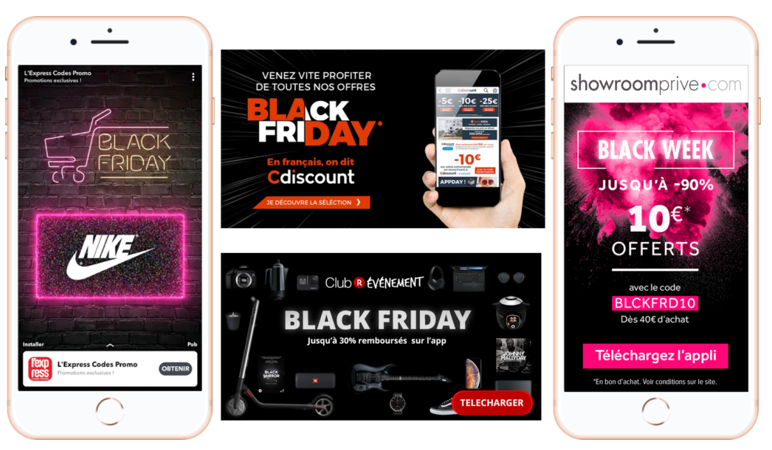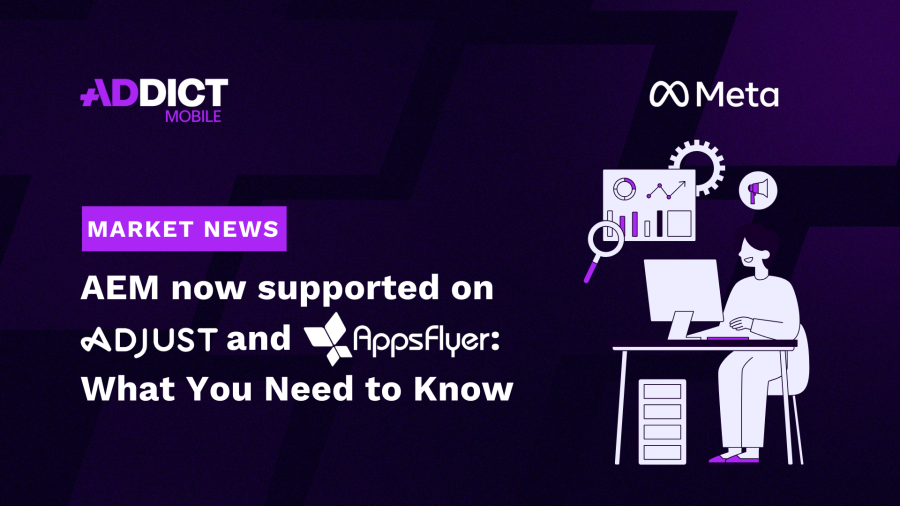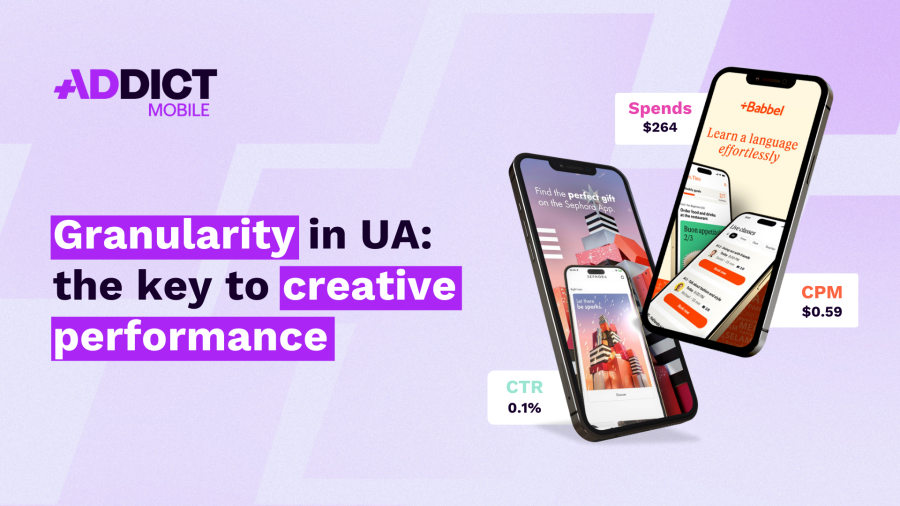Black Friday, Christmas, special operations: how do you come out on top for mobile acquisitions?

While 2021 has still been marked by the health crisis, Black Friday remains a period of sales and intensive consumption that is not to be missed by cell phone publishers, as it is the preferential channel for enda of year purchases.
In this case, we are interested in the entire end of year sales period that generally starts with Black Friday, on November 26 this year, and continues with Cyber Monday, the French Days, etc.
What are the price changes on the acquisition market? How do you carry out effective campaigns and maximize revenue from your app? Find all our tips in this article.
Boosting acquisition advertising spend during peak sales periods
Anticipation and timing are the watch words for Black Friday this year. In a study of purchasing behavior in 2020, Facebook informed us that 51% of consumers took advantage of a special promotional day to make their purchases. Furthermore, 23% of purchases were made before Black Friday. For advertisers, this means needing to start their campaigns upstream and communicate about both special offers and their application dates.
How do acquisition costs change during this period?
Black Friday is a highly competitive period. Most advertisers increase their budgets to ensure their presence over this crucial period. Even though acquisition costs are higher than over the rest of the year, the period nevertheless remains a highly profitable one. Indeed, in 2019 the CPM almost doubled* between November 1 and Black Friday. In 2020, this increase was smaller due to the economic slowdown following the COVID-19 pandemic, but it was still significant (+51% from November 1 to Black Friday*).
In addition, the installation rate reduces over this period as users are exposed to more advertising and thus become more selective about the apps they download. For advertisers who succeed in triggering this download, the reward is instant, with users who are more engaged than usual and wanting to make purchases (install-to-purchase conversion rate multiplied by 3 in 2018).

Advertising pressure relaxes sharply on the day following Black Friday and the CPM reduces by between 25 and 30%, which improves the acquisition costs. This is an initial decompression phase before the post-Christmas period, commonly known as Q5.
What strategy should be adopted for mobile acquisition? Our tips
As explained above, at Addict Mobile and according to the data gathered, we see increase of between 50 and 100% in the CPM between November 1 and Black Friday over the last 3 years*. At the same time, we see that the purchase transformation rates are multiplied by 3. As a result, it is profitable for an advertiser to invest highly during these key periods.
This competitive pressure means discounting more than usual in order to be visible on the various acquisition platforms and see campaigns made profitable. The aim is to seek out new users (and thus prevent them going to the competition), while reactivating regular buyers so that they are transformed during the sales period.
This even more true for apps, in as far as a user who has installed such is more likely to renew his/her purchases within the app than via a website.
Our tips for an efficient acquisition strategy
1. Don’t limit your budgets in order to seize every opportunity and thus generate high volumes while measuring the profitability of your actions via the various tracking tools. Don’t hesitate to increase bids, i.e., pay more for the display (CPM) or the download, in order to generate greater volume. In closely monitoring campaign profitability, you will quickly see if the ROI is positive. Keep in mind that by capping campaigns you risk cutting yourself off from part of your audience.
2. Retargeting is key. Deep-links will be your best friends, so that users land directly on the product or category that you will be showcasing in your visuals. It is important to correctly analyze your base upstream, in order to determine which sectors are most important (promotion lovers, purchaser on the previous Black Friday, inactive users, etc.). By retargeting these people with the right messages, you maximize your chances of getting your users back.
3. It is important to pair your branding strategy with acquisition campaigns and vice versa. This approach will allow you to instill your brand in the mind of your future buyers, especially when the latter will be looking to make their end of year purchases.
4. Don’t be reticent about higher acquisition costs (CPI or CPC) because it’s a strong bet that these will be offset by a very high purchase rate.
5. Tracking: ensure you have correctly configured all the events you want to measure through your tracking tools and check that the measurements are correct. The last thing you want to find is that your events are not feeding back correctly during the rush!
6. For the platforms that allow it, prepare your product catalog carefully; you can insert this directly into your adverts where applicable and automate your advertising campaigns according to your catalog (DPA). Most catalogs (Facebook, Snapchat, Google, Remerge, Critéo, etc.) are similar and so mutualize your efforts. Only Google requires a specific approach, so remember that. The DPA allows you to clearly know your audience and can help in identifying retargeting sectors. It allows for defining users in accordance with their behavior in the face of a given product (add to basket, abandon).
7. Don’t limit sources. When you’re seeking to generate greater volume, it is recommended you set up as many sources as possible. Be careful, however; it is important to anticipate all the sources you may be able to set up.
- Carry out tests upstream to find out which audiences work and discover the optimization possibilities offered by the platform. As a reminder, having an account history is favorable to your adverts being broadcast by the algorithms. Don’t set up a new source 2 days before Black Friday, as you won’t have the time to test it, and this may have an inverse effect on your campaigns.
With regard to App Store Optimization (ASO)
In the gaming industry, there are multiple app publishers who provide for a store page dedicated to key periods (screenshots highlighting the promotions, dedicated description). The aim consists in improving the land on store page > download conversion rates.
Note that some fields require the application to be re-submitted, which can be fairly long-winded, depending on the store (between a maximum of one to two weeks for Apple and a few hours on Android). If you want to set up dedicated actions, be sure to clearly anticipate this stage.
Here are a few tips to help you optimize your ASO.
– Modify your promotional text on iOS so that this doesn’t request the app to be re-submitted; furthermore, as this text would appear in the top slot on your store page, it is apropos to display promotional offers here, or elements specific to your key moments.
– Take care with the first screenshot or video, as these can help you highlight your offers! Now is the time to display promotions, in order to be quickly identified on the stores.
– For greater efficacy, adapt the icon, visuals, and title to the color codes for the key moments that are deployed on your website or in your app. In immediately landing in a clearly identified world (promotions, black color, Black Friday code, etc.) the client will be more inclined to download the app. This approach applies above all to e-commerce stakeholders and retailers who sell in bulk.
– Featuring during this key period can have a very strong impact on volumes and conversion rates. Consequently, it is essential to communicate regularly with the stores in order to showcase your app and potentially be featured – especially if you have a high added value offer.
– A/B test your store pages with iOS 15. The new OS allows for testing up to 35 variations of a store page, according to target.
Don’t forget to anticipate submission periods and remember to make these changes upstream of Black Friday in order to benefit from the entire period surrounding this event.
How to maximize the impact of creatives?
- At the same time, correctly pick up on the codes for all the operations you want to cover. For example, the color code for Black Friday is black. It is therefore important to reproduce this both within your app and your creatives. In the same vein, for Christmas, use the same codes and colors commonly used for this holiday in your creatives and your app. Consumers are programmed to identify black as the color of Black Friday, and thus of promotions.

- For more impact, highlight your competitive advantages and your promotions directly in your advertising visuals. A creative highlighting a product or a key offer will always be better performing that a general graphic, especially during a period as competitive as this!
- Video and story formats allow you to stage your products.
- Statics allow for making an impact at a glance, by significantly highlighting the promotion.
- Adapt the messages on your creatives to your targets: are these major clients, new purchasers, or re-engagement?
- Adapt your creatives to the sources: Benefit from platforms such as TikTok and Snapchat to deploy a creative strategy in close contact with your users (real shot, challenge, etc.)
*Study carried out on campaigns managed by Addict Mobile in 2018 on the Facebook platform only.
NEWS
Article in relation

AEM now supported on Adjust and AppsFlyer: What…
Adjust and AppsFlyer have just adopted Aggregated Event Measurement (AEM) in their attribution models. This integration of AEM by Adjust and AppsFlyer is...
Published on 18 October 2024
Interview with Íñigo Lopetegui, Regional Manager Middle East…
Meet Iñigo Lopetegui, Regional Manager Middle East at Addict Mobile. Since joining in 2022, he initially oversaw Southern Europe before shifting his focus...
Published on 16 October 2024
Granularity in UA: the key to creative performance
In user acquisition, creatives are a key driver to maximize campaign efficiency. To fully leverage this potential, it’s important to understand what works...
Published on 2 October 2024

